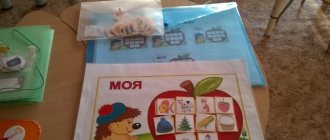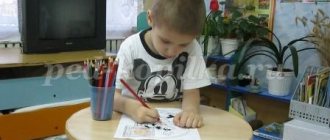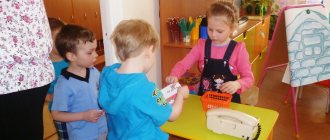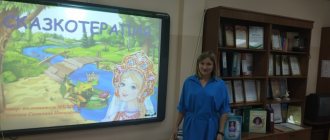Consultation for educators.
The teacher’s speech is the main source of speech development of children in kindergarten.
Requirements for the teacher’s speech culture.
Mastery of the native language as a means and way of communication and cognition is one of the most important acquisitions of a child in preschool childhood. It is preschool childhood that is especially sensitive to the acquisition of speech: if a certain level of mastery of the native language is not achieved by 5-6 years, then this path, as a rule, cannot be successfully completed at later age stages.
The main role in the development of speech and replenishment of the child’s vocabulary is played by the teacher and his speech, since the preschooler spends most of the time during this period of his life with him. For a child, an indispensable condition for his comprehensive development is his communication with the teacher. Among the many important tasks of raising and educating preschool children in kindergarten, teaching their native language, developing speech and vocabulary, and verbal communication is one of the main ones. This general task consists of a number of special, private tasks: nurturing the sound culture of speech, enriching, consolidating and activating the vocabulary, improving the grammatical correctness of speech, forming colloquial (dialogical) speech, developing coherent speech, cultivating interest in the artistic word, preparing for learning to read and write. In kindergarten, preschoolers, mastering their native language, master the most important form of verbal communication - oral speech. The educator is the conductor and support of this knowledge. A characteristic feature of preschool children is imitative speech, which is determined by the uniqueness of their perception and thinking. Not being able to think critically, children of this age imitate everything they see and hear in the environment, but most of all those people who are directly connected with them, towards whom the children have developed a positive attitude. Such a close person with whom a child is directly connected in kindergarten is the teacher. The behavior, speech of the teacher, his appearance - everything is a model for children. The originality of children's thinking and perception associated with imitation should be used in the upbringing and teaching of children, and, in particular, when teaching children their native language.
Knowing that preschool children master language on the basis of oral speech, through communication with people around them, the following should be taken into account.
1. The teacher’s speech is a model for children in the broad sense of the word, primarily in colloquial speech, on the basis of which the child’s daily communication with the teacher takes place.
2. During classes, children, listening to the teacher’s speech, practice mastering the Russian language. The shortcomings found in the teacher’s colloquial speech are passed on to the children, and then the children have difficulty getting rid of them at school.
What requirements must be made for the teacher’s speech?
1. The semantic content of speech addressed to a child should be close and understandable to children.
When talking with younger children, the teacher’s speech should be more concise and simple. In relation to children, one should avoid making comments and at the same time one should speak to them more categorically than to older ones, since children of this age cannot comprehend the arguments that are perceived by older children. “Yura, don’t dirty the tablecloth, eat with a spoon, don’t pour water on the floor,” etc., says the teacher to the younger children. Middle-aged and older children should be led to draw their own conclusions. For example: “You can’t dirty the tablecloth, it’s not neat. A lot of work goes into washing a tablecloth. We must protect the work of the people who wash our tablecloths.”
2. The grammatical correctness of the teacher’s speech is required.
But, unfortunately, the following mistakes are very common: “Take from the older group” (here the preposition “from” is replaced by “with”). ""Don't put it here" (instead of "don't put it here"). “I told you, but you don’t listen back.”
3. When communicating verbally with children, you need to use expressive language.
The monotonous, inexpressive speech of the teacher negatively affects the behavior of children, does not affect their emotions, and at the same time does not improve their speech culture. During lunch in the younger group, the teacher addresses the children who are eating slowly: “Eat, eat quickly, chew, swallow, don’t look around.” And this dry, monotonous appeal to children is repeated many times, the children do not react. In the same group, another teacher instills a positive attitude towards food in children in a completely different way: “What a delicious soup today! Look how beautiful the green peas are, grab them on a spoon quickly. Like this. Delicious” The child agrees. Or: “Natasha is smart today, she learned to eat quickly and accurately.” “And I can do it quickly,” the children’s voices are heard. “That’s right, Slava, your teeth are sharp, they can chew quickly,” the teacher confirms. The children smile and quickly finish their lunch.
4. The ability to express one’s thoughts accurately and convincingly is the most important quality of a teacher.
The teacher’s speech pattern in the classroom is of particular importance because it attracts the attention of all children to what the teacher says. The teacher’s speech pattern, both in everyday communication and in the classroom, should be used when carrying out all tasks: expanding the vocabulary, developing grammatical and sound correctness of speech. The skills acquired in the classroom must be made strong so that children can apply them in life. Meanwhile, there are often cases when the teacher does not think through his appeal to children. A particularly common mistake is verbosity and the use of unclear words. If, when drawing, the visual perception of a sample (object or pattern) is accompanied by a verbal explanation, without which children have difficulty completing the task, then in classes on mastering speech, the sample is even more important, because children master all aspects of speech only on the basis of auditory perception, on the basis heard from the teacher.
The emotional side of the model enhances the culture of listening and instills in children a desire to tell something themselves.
The teacher conducts gymnastics and outdoor games with middle group children. To increase children's interest in performing movements correctly, she resorts to expressive techniques. “The bunnies need to follow a straight path, the forest is thick, you can get lost, don’t lag behind each other.” The bunny children begin to jump faster.
In cultivating children's interest in words, it is necessary to use the expressive means of language not only in the classroom, but also in everyday communication. The requirements for the teacher’s speech in everyday communication are also mandatory when conducting classes. The teacher’s speech model in the classroom should be used when carrying out all tasks in working on speech development. When working with dictionaries, when teaching sound pronunciation, the teacher’s speech sample is especially important, since children learn new words in the correct sound.
Along with the requirements for a model teacher, it is necessary to say about the requirements of the teacher for children.
1. The teacher must not only give a speech sample to the children, but also check how the children have mastered it (for this, exercises and repetitions are used).
2. It is necessary to cultivate in children an interest in the ability to speak correctly (using incentives, an example of well-speaking children).
3. It is necessary to systematically monitor children’s speech, listen to how children speak, and correct mistakes in a timely manner.
Serious attention should be paid to children’s speech both in everyday life and in the classroom.
It should be said that the teacher’s speech pattern when teaching children can only be used when the speech culture of the teacher himself is impeccable
Consultation for educators on the topic: “Development of speech in preschoolers with the help of didactic games”
“Everyone can speak, but only a few of us can speak correctly.” These words, which I read once, gave me the idea that it is so important to teach a child not just to speak, but to express his thoughts correctly.
Speech culture is a very important part of personal characteristics. But, unfortunately, in our time, the level of Russian language proficiency among young people is declining, and interest in literature is also declining. As a result, children who are just learning to speak hear incorrect speech. And the inability to speak correctly turns into a vicious circle. Therefore, determining the directions for the development of correct speech in children is one of the most important pedagogical tasks.
According to the Federal State Educational Standard, preschool education “Speech Development” includes:
- mastery of speech as a means of communication and culture;
— enrichment of the active dictionary;
- development of coherent, grammatically correct dialogical and monologue speech;
— development of speech creativity;
— development of sound and intonation culture of speech, phonemic hearing;
— acquaintance with book culture, children’s literature, listening comprehension of texts of various genres of children’s literature;
— formation of a sound culture of speech as a prerequisite for learning to read and write.
A child’s speech develops gradually, along with his growth and development. A one-year-old baby begins to actively move in space and gain experience. This experience is reflected in the beginning of speech development. But the child grows and this experience becomes not enough. The child enters kindergarten, and the teacher needs to continue the formation and development of speech in conjunction with the general development of the child.
And here didactic games come to the rescue, which are not only a game for children, but also an excellent means of their learning and development. K.D. Ushinsky noted that children learn new material more easily during play.
Didactic games are a type of educational activities organized in the form of educational games that implement a number of principles of gaming, active learning and are distinguished by the presence of rules, a fixed structure of gaming activity and an assessment system, one of the methods of active learning. (V.N. Kruglikov, 1988.)
Didactic games promote:
— development of cognitive and mental abilities;
- development of children's speech;
- social and moral development of the child.
Didactic games differ in educational content, cognitive activity of children, game actions and rules, organization and relationships of children, and the role of the teacher. All didactic games can be divided into:
- games with objects (toys);
— printed board games;
- word games.
Games with objects are based on children's direct perception of the properties of the object. In these games, children learn to establish the similarities and differences of objects and become familiar with their properties. Examples of such games include “What is this?”, “Describe the object”, “Wonderful bag”, “Pick up the right object”.
Printed board games introduce children to the world around them. Children develop their mathematical abilities, attention, logic, and speech skills. These are games such as “Paired Pictures”, “Part and Whole”, “Loto”, “Travel Games”.
Word games are based on the direct use of speech. This is the most effective method of developing thinking and speech in children. Word games can occur anywhere and at any time, which is very convenient for using them, for example, while walking.
But for the successful development of a child’s speech, it is not enough just to play. The teacher’s competence in this matter is very important. To create conditions for the successful development of a child’s speech, the teacher must:
- be able to speak correctly;
— study methodological literature on this topic;
— rely on the experience of past years and apply modern technologies.
Thus, a teacher, like a child, must constantly develop and self-educate. After all, an educated teacher means educated children, and therefore an educated society in the future.






